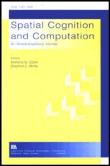
Spatial Cognition and Computation
Scope & Guideline
Innovating Insights in Spatial Cognition and Computation
Introduction
Aims and Scopes
- Spatial Cognition and Perception:
Research exploring how individuals perceive and understand spatial relationships in their environments, including studies on proprioception, spatial memory, and cognitive mapping. - Human-Computer Interaction in Spatial Contexts:
Investigations into how users interact with spatial information systems, including mobile navigation tools and their impact on spatial memory and learning. - Computational Models of Spatial Reasoning:
Development and evaluation of computational systems and algorithms for spatial reasoning, including software for declarative spatial reasoning and models for route planning. - Cultural and Linguistic Influences on Spatial Understanding:
Examinations of how different languages and cultural contexts influence spatial reasoning, including studies on spatial language and regional differences. - Embodied and Situational Approaches to Navigation:
Research on how physical engagement and situational contexts influence navigation strategies and spatial learning, including the role of landmarks and environmental features.
Trending and Emerging
- Interdisciplinary Approaches to Spatial Cognition:
There is an increasing trend towards integrating insights from psychology, linguistics, computer science, and design to address complex spatial cognition problems. - Impact of Technology on Spatial Navigation:
Recent studies focus on how technology, particularly mobile devices and virtual reality, affects spatial learning and navigation strategies, highlighting the relevance of user experience. - Role of Emotion and Stress in Navigation:
Emerging research is exploring how emotional states and stress levels influence navigation strategies and spatial decision-making, indicating a shift towards understanding cognitive processes in context. - Dynamic Mapping and Real-Time Navigation Systems:
Growing interest in developing systems that adapt in real-time to user needs and environmental changes, enhancing the relevance of spatial cognition research to practical applications. - Cognitive and Physical Interactions in Spatial Learning:
Research is increasingly examining how physical engagement and motor activities influence cognitive processes in spatial learning, underscoring the embodied nature of cognition.
Declining or Waning
- Traditional Theoretical Models of Spatial Cognition:
Research that strictly adheres to established theoretical frameworks of spatial cognition is becoming less prominent, as newer studies favor more integrated, interdisciplinary approaches. - Static Representations of Spatial Data:
There is a noticeable decline in studies focusing on static maps or representations, as the journal increasingly emphasizes dynamic and interactive spatial navigation systems. - General Studies on Gender Differences in Spatial Abilities:
While gender differences in spatial abilities were once a common focus, the trend is shifting towards understanding the underlying mechanisms and contextual factors that influence these differences. - Single-Domain Navigation Studies:
Research that focuses solely on either real or virtual environments without comparative analysis is decreasing, as there is a growing interest in understanding spatial cognition across multiple contexts. - Simplistic Assessments of Spatial Learning:
Simplified or one-dimensional assessments of spatial learning processes are being replaced by more complex, multi-faceted investigations that consider various influencing factors.
Similar Journals
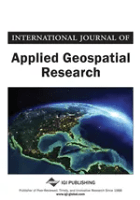
International Journal of Applied Geospatial Research
Driving insights in Earth and planetary sciences.International Journal of Applied Geospatial Research is an esteemed publication dedicated to advancing the field of geospatial research. Published by IGI Global, this journal provides a platform for innovative studies from 2010 to 2024 that encourage multidisciplinary contributions across Earth and planetary sciences and geography. While currently not offering open access, the journal's focus on applied research ensures that it remains highly relevant to both academics and industry professionals alike. With an ISSN of 1947-9654 and an E-ISSN of 1947-9662, it has been indexed in various databases, reflecting its emerging significance with rankings such as Q4 in Earth and Planetary Sciences and Geography according to Scopus, placing it at the intersection of critical research and practical application. Researchers, professionals, and students can expect insightful articles that enhance understanding and drive innovation in geospatial applications essential for informed decision-making in a rapidly changing world.

International Journal of Spatial Data Infrastructures Research
Advancing Geospatial Knowledge for a Sustainable FutureThe International Journal of Spatial Data Infrastructures Research is a prestigious, open-access publication dedicated to advancing knowledge in the field of spatial data infrastructures. Published by the European Commission, Joint Research Centre, this journal has been a vital resource since its inception in 2006, promoting innovative research that informs policy and practice in geographic information systems and spatial data management. With a robust commitment to open access, the journal ensures that critical findings are readily available to researchers, professionals, and students globally, fostering a collaborative environment for the development of spatial technologies. The journal's unique focus on spatial data infrastructures makes it an essential platform for sharing empirical studies, theoretical advancements, and practical applications, ultimately driving the evolution of smart, sustainable geospatial solutions.
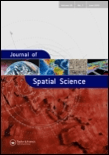
Journal of Spatial Science
Advancing Interdisciplinary Insights in Spatial ScienceThe Journal of Spatial Science, published by Taylor & Francis Ltd, serves as a prominent platform for the dissemination of research in the interdisciplinary fields of geography, atmospheric science, and energy. With an ISSN of 1449-8596 and an E-ISSN of 1836-5655, this journal has established itself as a vital resource since its inception in 2004, boasting an impressive convergence period extending to 2024. Recognized in the Q3 quartile for Atmospheric Science and Energy (miscellaneous), and achieving a Q2 classification in Geography, Planning and Development in 2023, the journal not only reflects the evolving complexities of spatial science but also underscores its increasing relevance in addressing contemporary global challenges. The journal holds a commendable position in Scopus rankings, with notable placements in various categories, further highlighting its academic significance. Researchers, professionals, and students are encouraged to engage with the rich content offered, as the Journal of Spatial Science remains committed to advancing knowledge and fostering discussions pertinent to spatial analysis and its applications.
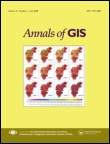
Annals of GIS
Exploring the Frontiers of Spatial ScienceWelcome to the Annals of GIS, a leading academic journal published by Taylor & Francis Ltd, dedicated to advancing the field of Geographic Information Science and its applications. With an ISSN of 1947-5683 and an E-ISSN of 1947-5691, this Open Access journal has been ensuring wide accessibility since 2019, thereby bolstering the dissemination of knowledge in areas such as remote sensing, spatial analysis, and geoinformatics. Hailing from the United Kingdom, the journal ranks impressively within its categories, achieving a Q2 status in Computer Science Applications and a prestigious Q1 ranking in Earth and Planetary Sciences for 2023, placing it in the top 10% among its peers. With a focus on innovative research spanning from 2009 to 2024, the Annals of GIS serves as a vital platform for researchers, professionals, and students alike, providing insights and fostering discussions that push the boundaries of geographic technologies and their real-world applications.
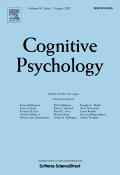
COGNITIVE PSYCHOLOGY
Exploring the Depths of Human CognitionCOGNITIVE PSYCHOLOGY is a premier academic journal published by Academic Press Inc. Elsevier Science, specializing in the dynamic and evolving field of cognitive psychology. With a significant history spanning from 1970 to 2024, this journal has established itself as a critical resource for researchers and professionals alike, boasting a distinguished ranking in the Q1 category across multiple disciplines, including Experimental and Cognitive Psychology, Neuropsychology, and Artificial Intelligence. Its impact factor, reflective of its influence and reputation within the academic community, positions COGNITIVE PSYCHOLOGY as an essential platform for disseminating cutting-edge research and theoretical advancements. Although it is not open access, subscribers gain exclusive insights into the latest findings that drive the field forward. The journal's commitment to fostering innovative research makes it an indispensable tool for those dedicated to understanding the complexities of human cognition.
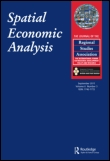
Spatial Economic Analysis
Innovating the Future of Spatial Economic ResearchSpatial Economic Analysis, published by Routledge Journals, Taylor & Francis Ltd, stands at the forefront of interdisciplinary research bridging economics, geography, and environmental science. With a notable impact factor reflected in its prestigious Q1 quartile rankings across key categories such as Earth and Planetary Sciences, Economics, Econometrics and Finance, and Geography, this journal is pivotal for scholars seeking to understand the intricate dynamics of spatial phenomena and their economic implications. Its comprehensive scope and rigorous peer-review process ensure that only high-quality research is disseminated, fostering innovative solutions to pressing global challenges. As of 2024, and since its inception in 2006, Spatial Economic Analysis continues to thrive as a vital platform for researchers, professionals, and students alike, facilitating access to cutting-edge studies that shape the future of spatial economics and policy.
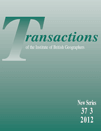
TRANSACTIONS OF THE INSTITUTE OF BRITISH GEOGRAPHERS
Innovating Insights into Spatial DynamicsTRANSACTIONS OF THE INSTITUTE OF BRITISH GEOGRAPHERS is a prestigious journal published by Wiley, focusing on the dynamic field of geography and its multifaceted interactions with earth-surface processes. With an ISSN of 0020-2754 and an E-ISSN of 1475-5661, this journal has made significant contributions to the discipline since its inception in 1976, continuing to publish groundbreaking research that shapes contemporary geographical thought until 2024. Recognized for its rigorous scholarship, it is classified within the top quartile (Q1) of both the Earth-Surface Processes and Geography, Planning and Development categories. The journal holds respectable rankings in Scopus—91st out of 821 in Social Sciences and 22nd out of 179 in Earth and Planetary Sciences—placing it in the 88th and 87th percentiles, respectively. Although it operates under traditional access policies, the depth of research, variety of topics, and the interdisciplinary approach make it an invaluable resource for researchers, professionals, and students alike, promoting a deeper understanding of spatial dynamics and planning within our rapidly changing world.
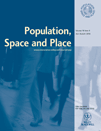
Population Space and Place
Connecting People, Places, and PoliciesPopulation Space and Place is an esteemed academic journal published by WILEY, dedicated to advancing the fields of demography and geography, planning, and development. With an impressive 2023 impact factor and categorized in the top quartile (Q1) for both demography and geography, this journal serves as a vital platform for researchers, professionals, and students seeking to explore the spatial dimensions of population dynamics. Founded in 2004 and running through 2024, it has established itself as a significant contributor to scholarly discussions, evidenced by its high Scopus rankings, including rank #18 out of 139 in demography and #165 out of 821 in geography and planning. While the journal currently does not offer open access, it remains a key resource for those involved in academic research and policy formulation. With its focus on the interplay between population trends and spatial analytics, Population Space and Place is essential for anyone aiming to understand the complexities of population geography in a rapidly changing world.
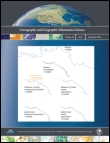
Cartography and Geographic Information Science
Shaping Tomorrow’s Geography Through Scholarly ExcellenceCartography and Geographic Information Science is a premier journal published by Taylor & Francis Inc, focusing on the interdisciplinary realms of geography, planning, and technological innovation. With an impressive impact factor and ranking in the top quartiles across various categories, including Q1 in Geography, Planning and Development and Q2 in Civil and Structural Engineering, this journal serves as an essential resource for researchers, professionals, and students alike, promoting cutting-edge research and advancements in cartography and geographic information systems. The journal disseminates high-quality articles that explore both theoretical and practical aspects of geographic information, aiming to enhance the understanding and application of spatial data. As the field evolves, Cartography and Geographic Information Science remains a vital forum for innovation and scholarly dialogue, offering accessible content to a global audience. With its commitment to rigor and relevance, it plays a critical role in advancing the landscapes of geography and environmental sciences.

Geograficidade
Innovating Solutions for Contemporary Geographic ChallengesGeograficidade is an esteemed academic journal published by the Federal University of Fluminense in Brazil, focusing on the interdisciplinary fields of geography, spatial analysis, and environmental studies. With its ISSN 2238-0205, this journal serves as a crucial platform for researchers, professionals, and students to disseminate innovative research, theoretical discussions, and practical applications pertaining to geographic phenomena. Although currently not listed as open access, Geograficidade aims to make significant contributions to the understanding of geographic dynamics and their implications on societal and environmental issues. The journal emphasizes the importance of rigorous scholarship and encourages submissions that explore contemporary geographical challenges and promote sustainable solutions. Its vibrant community of scholars fosters a rich dialogue, making Geograficidade a vital resource for anyone engaged in geographic research and academia.